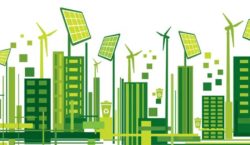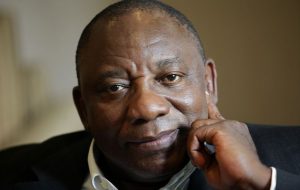

SOUTH Africa has been hit by rolling power cuts less than a month after President Cyril Ramaphosa gave renewed assurances that energy constraints were being addressed, making his pledges ring hollow and highlighting his administration’s inability to tackle the crisis.

Cyril Ramaphosa, President of South Africa.
While Eskom Holdings, the State utility that provides about 95 percent of the nation’s electricity and is overseen by Public Enterprises head Pravin Gordhan, has borne the brunt of the blame for the outages, criticism is increasingly being directed at another target: Mineral Resources and Energy Minister Gwede Mantashe, who is also chairperson of the ruling party.
The 64-year-old former miner and labor union leader is one of Ramaphosa’s most important political allies, yet his reticence to fast-track renewable power projects could prolong the electricity shortages, which have caused the economy to stagnate and sapped investor confidence.
Increased use of solar and wind energy would reduce South Africa’s reliance on coal, which is currently used to generate the bulk of electricity utilized in the continent’s most industrialized economy. That prospect bodes ill for about 87 000 coal miners, many of them members of the National Union of Mineworkers, which Mantashe led from 1998 to 2006.
“He is a calculating man. The reason he is where he is is because he comes with the unions,” said Ralph Mathekga, an analyst and author of books on South African politics.
“He manages to restrain Ramaphosa in the interest of his old traditional allies.”
Furthermore, private producers dominate the production of green energy and an enhanced role for them would mean a diminished one for Eskom and increase pressure on the utility to trim its bloated workforce of more 46 000 people — a prospect vigorously opposed by the unions.Mantashe “does not believe in privatisation,” Mathekga said. “He is a trade unionist at heart.”
The gravity of the situation has been demonstrated by several days of outages at a time when many power-hungry factories are closed for the holiday season. Most will restart this week, adding strain to the grid.
One of the quickest ways to boost electricity output would be to allow private business to generate as much as 10 MW without a license, up from a current limit of 1 MW. While former Energy Minister Jeff Radebe initiated the process of raising the threshold last year, Mantashe has failed to follow through since assuming the energy portfolio in May.
“Nothing is being done” to enable additional power generation, said Dave Long, general secretary of the South African Independent Power Producers Association. “They are just dragging their feet.”
Sibanye Gold, the country’s biggest precious metals producer, has failed to get approval for a 150 MW solar plant, and many other firms have experienced similar problems, its CEO Neal Froneman said last month.
The government could also tap private producers to supply more renewable power to the grid. South Africa had one of the world’s most successful green energy purchase programs, but stopped seeking bids for new projects in 2016 as former President Jacob Zuma pushed a nuclear power deal with Russia that’s since been abandoned.
— Bloomberg